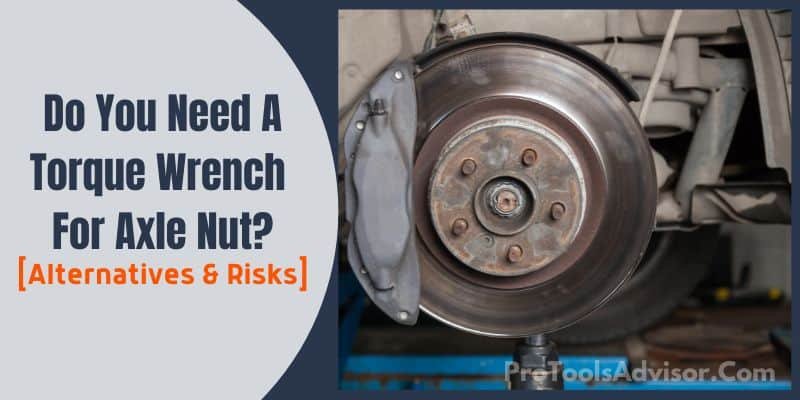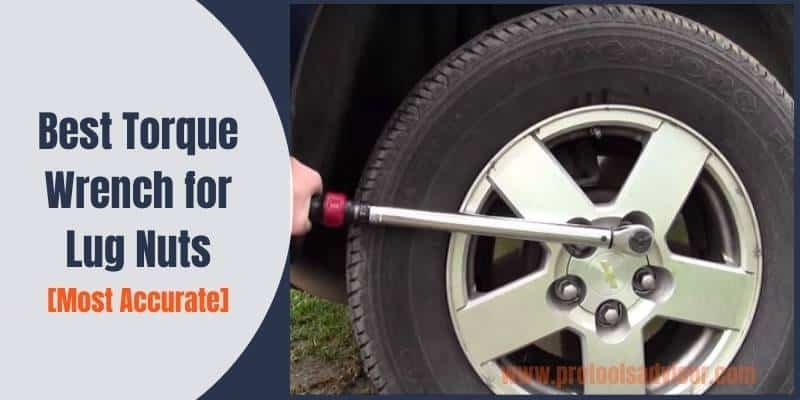Disclosure: This post contains affiliate links and I will be compensated if you make a purchase after clicking through my links. Learn More
Axle nuts fasten the wheels to the rotating shaft of your car, and you need to tighten them whenever you replace the tires with new ones. But the problem arises when we can’t measure the ideal torque these nuts need to be perfectly tight.
So what will happen if you over-torque an axle nut?
The straight answer is that you can damage the hub assembly and wheel completely. The nuts might lose their elasticity and come off while you drive. The only way to avoid such mishaps is by using a torque wrench.

Axle nuts are highly sensitive to how much torque they receive. That’s why experts suggest using torque wrenches for precise tightening. If that doesn’t satisfy your quest, keep reading. Below we have explained why you need a torque wrench for axle nuts, how to use it, the alternatives if you don’t have one, and the risks you need to be aware of.
Let’s get started!
Why Do You Need A Torque Wrench For Axle Nut?
You should always torque the axle nuts according to the manufacturer’s specification. And the best way to do this is by using a torque wrench.
You can damage the wheel bearing if you choose, for example, an impact to tighten down the axle nut all the way. Since the suspension is at full droop on the left CV axle and the tripod joint, typically at the transaxle, could be damaged by the impact. The tiny needle bearings and also the surfaces inside of the joints can be damaged as well. So the best practice is to tighten down by hand first and then use a torque wrench to tighten the nuts to the manufacturer’s recommended specifications.
If you are wondering why you should use a torque wrench over the other tools for axle nuts, we want to remind you of the following benefits:
Precision
Precision is key when adjusting axle nuts on the wheelset. Axle nuts are more prone to damage if you apply the wrong torque. Car manufacturers strictly warn users to apply the instructed torque only.
And, that’s only possible through a torque wrench. The wrench has an attached scale marked in Foot- Pounds or Kilogram-Meter. You can set the scale up to the required point. That way, while you’re tightening the axle nuts, it can warn you that the pre-set torque has been reached. It makes the process much simpler.
If you don’t use a torque wrench, there is no way to measure the exact torque level. If you are experienced enough, you might use your hand or some other tool to tighten the nuts, but there is always the risk of over tightening and injuries.
Easy To Handle
Axle nuts are more difficult to tighten than lug nuts. If you use a normal ratchet, these nuts will slip off easily. You need a special tool that is designed to get a hold of hard-to-reach nuts and bolts. That’s what the torque wrench was made for.
It comes with a perpendicular structure and handles with extension bar to hold the socket. Due to this, you can fit it into confined areas easily. You can also maneuver the tool better.
Extra Leverage
Now, let’s talk about leverage. The force you provide to one end of a beam will be multiplied by the distance it travels to the other end. As a result, the impact will be much more than what you started with. Suppose you pushed a lever with 15 N of force and the length of the lever is 3 m. So, what will be the force received on the other side?
It will be 15 x 3 = 45 Nm (newton-meter). Your small forces will be enough to tighten the bolt, which was manually impossible to pull off with any other tool. The work will be done more easily if you use a torque wrench.
How to Tighten Axle Nuts Using a Torque Wrench?
You should use torque wrenches to avoid damaging the threads of the axle nuts through over-tightening. You will be okay with a ½” torque wrench that can handle up to 100 to 110 foot-pounds. And, here’s how you can use it properly.
- Grab your adjustable torque wrench. The first thing we will do is adjust the scale. For that, you have to loosen up the locking knob. It allows the scale to move freely.
- Now rotate the wrench handle to set the scale to the manufacturers’ recommended specification. If it is 100 ft-pounds for your car’s axle nut, keep rotating the handle until it reaches “0” on the scale and matches with the mark “100.”
- Once it reaches the desired level, lock the knob again. It will keep the scale in that position.
- Your torque wrench is now ready to use. Insert the socket into the wrench head and place it on top of the nuts. Hold the handle that you just adjusted and give it enough force until you hear a clicking sound. The clicking sound means that the axle nuts have been tightened to the desired torque level.
- Apply the same methods to the other axle nuts.
What If You Don’t Have A Torque Wrench?
If you don’t have a torque wrench with you right now, there are some alternatives that you can use. However, the application of these alternatives can be risky. So consider them only if you have urgency and a lot of experience using these tools before.
Impact Wrench
Impact wrenches can be a quick getaway for you. It works in the same way. You insert the socket into the head and pull the trigger. If you just want a quick snap, it will do the work. The problem with torque wrenches is that they only work for tightening bolts. But, with impact wrenches, you can both tighten and loosen small fasteners.
Breaker Bar
Breaker bars are usually used to loosen nuts, hence the name “breaker bar”. But you can use this tool to tighten the axle nuts as well. Because of their extra length, they can apply more torque than a regular socket wrench. But we won’t recommend it because there is a risk of damage. They are non-ratcheting, so they are best used for breaking nuts, not tightening them.
Risks Associated with Alternatives
Over Tightening
The major problem with using an impact wrench is that you can’t measure it. Digital torque wrenches show you the number on a screen. But, with impact wrenches, all you can do is guess.
There are high chances of over-tightening. It can lead to a reduction in the life expectancy of the hub bearings.
Loose Fit
Just like the over-tightening issue, there is a chance of not tightening it enough. Since there is no measurement, the nuts can come off as the wheels move. It can make the wheel move back and forth as you drive. The outcome can be even worse if the bolts are dedicated to keeping dangerous liquids inside.
Wear and Tear
Not measuring the torque will cause premature wear and tear to the threads of the nuts. The torque must be kept within the elasticity limit of the nuts. But, without a torque wrench, you might cross that level without even realizing it.
Final Words
Finally, we hope that the above information has helped you understand why you need a torque wrench for axle nuts. Although there are some alternatives you can consider, keep in mind the potential consequences and take the risks yourself.
If you have any specific questions that we haven’t addressed above, please leave a comment below and we’ll do our best to respond as quickly as possible. Thanks for reading!


